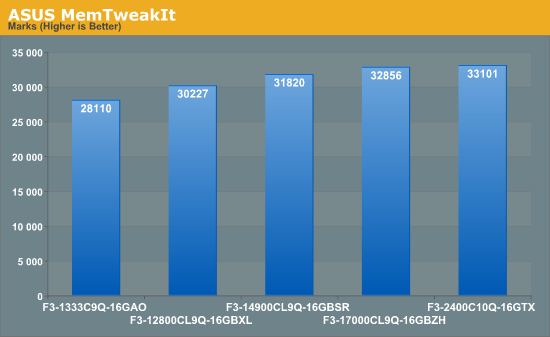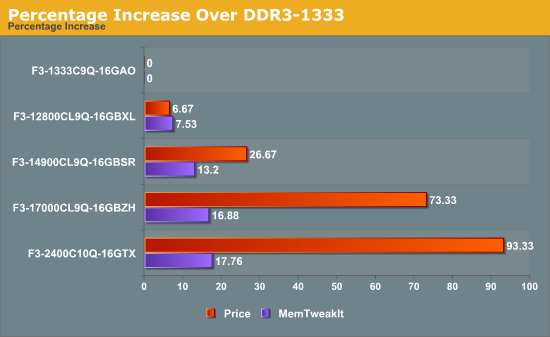Memory Performance: 16GB DDR3-1333 to DDR3-2400 on Ivy Bridge IGP with G.Skill
by Ian Cutress on October 18, 2012 12:00 PM EST- Posted in
- Memory
- G.Skill
- Ivy Bridge
- DDR3
Market Positioning
Over recent years the price of DDR3 memory kits has hit record lows quarter on quarter. This means that profit margins for companies are also getting smaller and smaller – it becomes hard to differentiate yourself as a product line on price alone. This is the reason why a lot of the kits we have looked at today are designed to be visually eye catching – having either colored heatsinks, detachable heatsinks or shaped designs.
The pricing for each of the kits are as follows:
$75: Ares DDR3-1333 9-9-9 4x4 GB
$80: RipjawsX DDR3-1600 9-9-9 4x4 GB
$95: Sniper DDR3-1866 9-10-9 4x4 GB
$130: RipjawsZ DDR3-2133 9-11-10 4x4 GB
$145: TridentX DDR3-2400 10-12-12 4x4 GB
The margin between the 1333 MHz and 1600 MHz kits is $5, and as such would only be differentiated between tight budget constraints, bulk sales or aesthetic looks. The jump up to 1866 MHz is slightly more, but going up to DDR3-2133 and beyond is a significant jump in price, indicative of the binning process required for these higher end modules. The testing in this review will show if the leap up to DDR3-2133 memory is proportionally a good idea.
Test Bed
| Test Bed | |
| Processor |
i7-3770K @ 4.4 GHz 4 Cores / 8 Threads |
| Motherboard | ASUS P8Z77-V Premium |
| Memory |
G.Skill 1333 MHz 9-9-9-24 1.5V 4x4GB Kit G.Skill 1600 MHz 9-9-9-24 1.5V 4x4GB Kit G.Skill 1866 MHz 9-10-9-28 1.5V 4x4GB Kit G.Skill 2133 MHz 9-11-10-28 1.65V 4x4GB Kit G.Skill 2400 MHz 10-12-12-31 1.65V 4x4GB Kit |
| CPU Cooler | Intel Stock Cooler |
| Graphics Cards |
Intel HD4000 ECS GTX580 |
| Power Supply | Rosewill SilentNight 500W Platinum |
| Storage | OCZ Vertex3 240GB |
| SATA 6Gbps to USB 3.0 | Thermaltake BlacX 5G Docking Station |
| Thunderbolt Device | Lacie Little Big Disk 240GB |
| Test Bench | Coolermaster Test Bed |
| Operating System | Windows 7 x64 Ultimate |
Many thanks to...
We must thank the following companies for kindly donating hardware for our test bed:
OCZ for donating the USB testing SSD
G.Skill for donating our memory kits
ASUS for donating the IO testing kit
ECS for donating NVIDIA GPUs
Rosewill for donating the Power Supply
I would like to extend thanks for Rosewill, as this is the first review we have used their new SilentNight 500W Platinum power supply. I first saw this bit of kit at Computex – a silent power supply capable of 500W and Platinum certified sounds like a great bit of kit and it was flawless during out testing. When I received the power supply I made an unboxing video before it went on sale:
It currently retails for $180 on Newegg.
ASUS MemTweakIt
With our overview of the ASUS Republic of Gamers range of products, one piece of software caught my eye while I was testing. The ASUS MemTweakIt allows for almost complete control of the memory subtimings while in the OS, such that users can optimize their settings for memory reads, memory writes, or for pushing the boundaries. The upshot of this software in our context is that it takes all the sub-timings and settings and condenses them into a score. As the memory kits we test contain XMP profiles, these profiles determine a large majority of the sub-timings on the kit and how aggressive a memory manufacturer is. We should see this represented in our MemTweakIt score.
As we do not know the formula by which ASUS calculates this value, it has to be taken with a pinch of salt. It could be weighted in favor of one of the settings versus the other. Normally I would not put such an non-descript benchmark as part of our testing suite, but the MemTweakIt software does give us one descriptor – it gives us a theoretical rate of improvement across the range of kits we test, and allows us to order them in the way they should perform. With this being said, the results for our kits are as follows:


The rise in MemTweakIt score does not follow the price increases – for an almost doubling of the cost of the memory kit, we only see a 17.76% rise in the score. What this score means, we will see in due course.










114 Comments
View All Comments
crackedwiseman - Thursday, October 18, 2012 - link
OK, just one question: why in the hell are the IGP memory tests done on an i7? The results would be much more meaningful if the tests were on an AMD A10 or similar - it has a beefier IGP, and thus would be more bandwidth-bound.creed3020 - Thursday, October 18, 2012 - link
100% Agree. Doing these tests against a Trinity APU would have been much more interesting from a iGPU point of view. It it well known that AMD APUs benefit from increased memory bandwidth, AT has yet to test Trinity for this yet they did it for Llano.silverblue - Thursday, October 18, 2012 - link
It makes sense to test; HD 4000 is far superior to HD 3000 and it is worth knowing if that extra power is bandwidth limited. Generally, it is a little, though nowhere near as much as AMD's equivalents are.JonnyDough - Monday, October 22, 2012 - link
Not to mention, it's surprising to me that AMD wasn't mentioned as a company trying to match memory to motherboard. AMD started making their own memory modules, an interesting fact I think.SeanJ76 - Saturday, June 21, 2014 - link
AMD is a decade behind Intel, in processor technology and instructions, it really doesn't matter what AMD attempts to do....SeanJ76 - Saturday, June 21, 2014 - link
No one gives a shit about APU you moron......these are desktop tests!hp79 - Thursday, October 18, 2012 - link
Maybe because more people use intel? I agree that it would have stood out more if it was AMD's IGP, but doing the test on intel IGP is also okay and gives an idea of what to expect. I think the article is fine. Besides, do people really play games with IGP? If I am playing demanding games, I want the frame rates to be minimum 60 fps. That's why I use a dedicated graphics card. This might change when AMD's IGP gets even more powerful, but for now I think it's still not there yet.zcat - Thursday, October 18, 2012 - link
> Besides, do people really play games with IGP?Some of us do. My miniitx i7 is primarily for work & everyday use, but its HD4000 is fast enough for Portal 2 and Diablo 3 to be very playable @ 1920x1080p with AA off.
However, I know the limits of IGP, and intend on upgrading to an overclocked GeForce GTX 650 Ti very soon in order to play some more demanding games this winter.
sking.tech - Monday, October 22, 2012 - link
you may want to reconsider your choice of video "upgrade"nvidia's 2nd number is more significant than the first as far as overall gaming graphics power goes... You'd do better going for a 560 TI than a 650 for approx the same cost
Dirk Broer - Wednesday, July 24, 2013 - link
You should first look at what chip actually powers the card -and it's capabilities- before staring yourself blind on the last two digits. Besides that, a GTX 560 Ti is more expensive than a GTX 650.